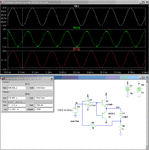- Joined
- Jan 22, 2008
- Messages
- 52,383
- Helped
- 14,746
- Reputation
- 29,774
- Reaction score
- 14,089
- Trophy points
- 1,393
- Location
- Bochum, Germany
- Activity points
- 297,930
Maybe I'm relying too much on the original specification that talks about DDS and 1 A sinoidal current.It may be straightforward but not necessary simple or easily made stable with an inductive load. Since he stated that a square-wave would be okay, I showed a simple circuit that generates a current limited output and is stable with an arbitrary inductive load.
I think that the stability problems can be easily overcome, but yes a certain analog design knowledge will be required.
Instead of feedback, current control through software might be an option, requiring a current measurement however.
A discrete transistor driver isn't bad as such. I would prefer internal feedback per stage instead of being stuck to transistor current gain variations and nonlinearity.


